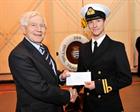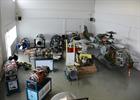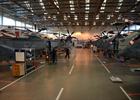Air Engineering for the 21st century
Following the decision by the Fleet Air Arm Officers Association to contribute a prize for the ‘best trainee AEO’ of the year, the author visited HMS Sultan to make the presentation and see for himself how today’s young AEOs are trained.
The winner of the prize for the course ended July 2013 was Lt Mark Stone. He came back from RNAS Yeovilton to receive his prize, and will return there immediately to take his C-of-C on the Sea King Mk.4 to join 845 Sqn as a junior AEO. His instructors spoke highly of his motivation and results.
HMS Sultan is part of the Defence Engineering Command which covers the three separate service establishments within the tri-Service College of Technical Training. Thus, in overall command is a Commandant, Commodore DE Elford RN, based at RAF Cosford , itself the RAF school, Arborfield (near Reading) for Army training and HMS Sultan for the RN. This last covers all RN engineering sub-specialisations – Marine, Nuclear, Submarine and Air. Commodore Elford was the FAA Chief Engineering Officer, and was the leader of the Lynx/Wildcat introduction team.
The task of the Royal Naval Air Engineering and Survival School (RNAESS) is to train all the Fleet Air Arm engineers from Air Engineering Technician(AB), through to Pre-Charge AEOs (Cdr and Lt Cdr). The ratings will have started at HMS Raleigh for their basic training, and the AEOs will be graduates with a suitable degree (with an avenue for Upper Yardmen) and will have been selected by the AIB and been sent to Dartmouth for 30 weeks for ‘military’ and ‘marinisation’ training. Their degree will probably have been awarded by either Portsmouth or Southampton Universities. The AEO of the future will be neither (M) or (L) nor Air Ord - but will be multi trade, able to cover all aspects of aircraft support. This period will be followed by 12 weeks on board a CVS or LPH where they will cover time in every department.
With this basic grounding, they will arrive at HMS Sultan for specific Air Engineering training – albeit generic and not related to any particular aircraft type. That comes later at an airstation Training School. Whilst at Sultan, they are instructed both in the classroom and in the hangars on aircraft systems, engines, helicopter transmission, flying controls, the computers which enable the systems to work, and in ‘battle damage repair’ in case the mobile repair teams are unavailable. They also cover radar and sonar including the analysis equipment carried in the aircraft. They receive a certain amount of aviation theory – from aerodynamics, theory of flight, structures and the stresses therein. There are wind-tunnels for conducting limited experiments and they learn about vibration analysis (HUMMS and SOAP). What they do not cover extensively is workshop practice with little metal forming or turning.
However, by the end of a fairly intensive 44 weeks course, they are examined and pass-out to go to the Fleet. This final examination satisfies the Institutions and RAeS of their capabilities and then they pass onto one of the airstations and are attached to a squadron for their Certificate of Competence training and test. Then they join a squadron operating the same type of helicopter as they have just trained on.
The ratings at Sultan will have seen their future officers being trained on the same aircraft systems as they will learn. They are attached to a ‘squadron’ at Sultan – historically called 760 and 764 squadrons. These have (at present) both Sea King and Lynx helicopters on which they will work, performing a range of component changes and servicing operations, the squadrons each have an Issue Centre for learning correct procedures, and the technicians work with actual and current aircraft publications and servicing books. After their Initial Engineering Qualifying Course they are then divided into Mechanical or Avionics depending partly on preference, partly on Fleet requirements. Then subsequent courses for Leading Hand and Petty Officers are tailored in each subspecialisation to ensure that as Technicians they really know their part of ship. They then return to their airstations and squadrons to put into practice what they have learned. At appropriate points in their careers they will return to HMS Sultan for the course for the next higher rate.
At the time of writing, the RNAESS has numerous Sea Kings (all due to phased out by 2016) and some Lynx. A Merlin airframe is available for introduction as the AS Mk.2 is already in service and RN technicians are training at RAF Benson in preparation for the conversion of the ex-RAF Mk.3s to RN Mk.4 standard with corrosion resistance, marinised engines and folding main rotor heads. These last will go to 845 Sqn in due course as the first Merlin Commando squadron. There is a strong contingent working and training in the USA on fixed-wing aircraft including F18 and (the first) F35Bs. In due course, this last task will transfer to the UK once the Lightning II aircraft start being delivered.
Cdr SE Askins RN, December 2013



